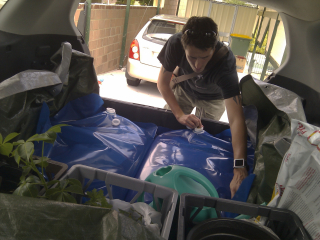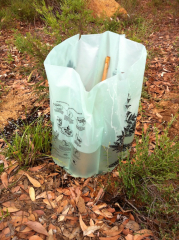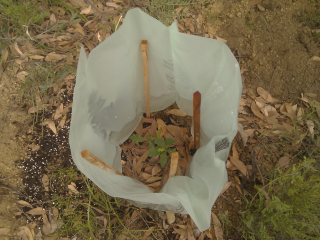No scheme water, and no bore or rainwater tanks in place, made irrigation over the summer a very labour intensive task. So every weekend we filled up a couple’ve barrels with water and drove them up to Gallifrey, then manually transferred the water to the water tubes around each of the trees using watering cans.
We tried a few water containers, and experiment showed that the recycled plastic olive barrels fitted with taps were the best. The flexible plastic water bladders that we tried first didn’t hold much water, and sprung leaks after two or three uses. The plastic slimline rainwater tank from Bunnings was better, but the lid didn’t seal, and the tap attachment wouldn’t take a regular hose, meaning that we had to siphon water out from the top. Slow.
It could have been worse; our neighbour thought we were manually watering each of the tree seedlings every weekend. The water tube tree guards were a life saver; they’re UV resistant plastic tree guards with a built-in 20L water bladder and a dripper in the base. The water drips out slowly over (in theory) 2 weeks. In hot weather the water in the water tube expands, forcing the drip rate to increase, while in cooler weather and at night when the plant requires less water the drip rate decreases.
So far, we have four fig trees (Ficus carica), all different varieties, two pomegranates (Punica granatum), a natal plum (Carissa macrocarpa), an acerola cherry (Malpighia glabra), two honey locusts (Gleditsia triacanthos), a baby boab (Adansonia gregorii), three kei apples (Dovyalis caffra), and four moringas (Moringa oleifera) planted. Those are the food trees. Yes, boabs count as food trees. There are also two oak trees (Quercus spp., acorns collected from Stirling Gardens in Perth), a dieback resistant jarrah seedling (Eucalyptus marginata) that a friend gave us, a few dozen wattles, mainly Acacia victoria, but also some Acacia acuminata and Acacia pycnantha, a few pink siris (Albizia julibrissin), and one or two black locust trees (Robinia pseudoacacia).
The plan is to plant a shelter belt around the entire perimeter, inside the mandatory firebreak, consisting of thorny natal plum, kei apple, boysenberry (Rubus x boysenberry) and sea buckthorn (Hippophae rhamnoides), as well as fire retardant trees like oaks, maples, sweetgum, hazel and prickly pear. Eventually, it will be a noise buffering fire barrier in the form of a hedgerow. Inside that will be a secondary firebreak, planted with grain and meadow plants in winter, and space loving succulents and vegetables like squash in the summer. Inside that will be the forest, and the house.



Anyone interested in the water tubes should look them up – it’s a brilliant idea and they work really well. We bought ours from http://www.suregro.com/tree-protection/water-tubes/water-tube-guard.html
this is fantastic…really enjoying reading your site. .i know baobabs from africa but had no idea you could grow them in Aus. i want one! but it sounds like it could end up the actual size of my pitiful garden lol. 🙂